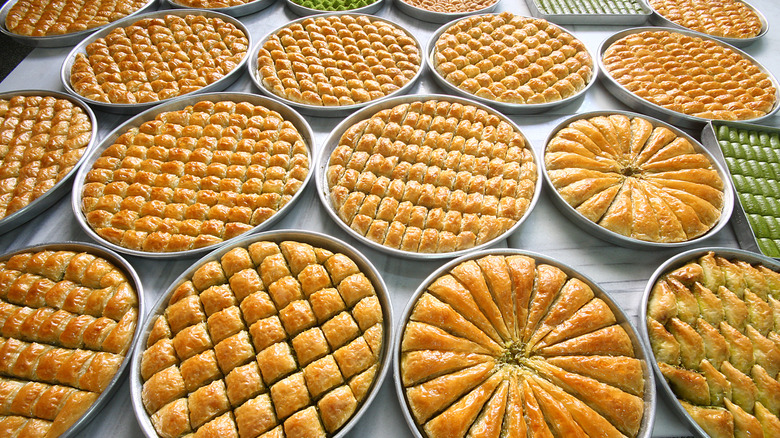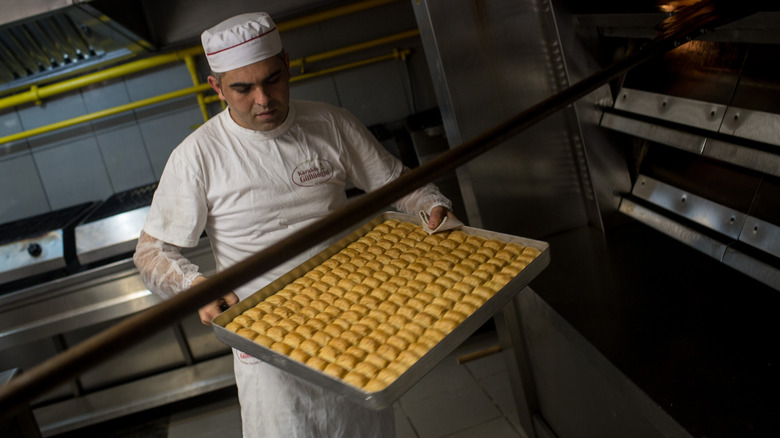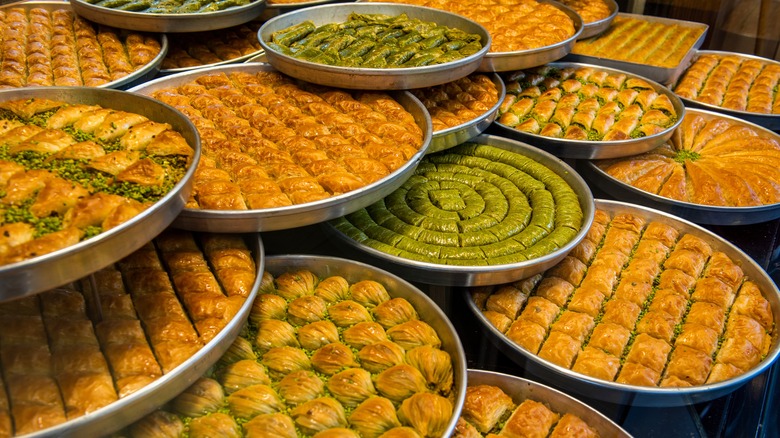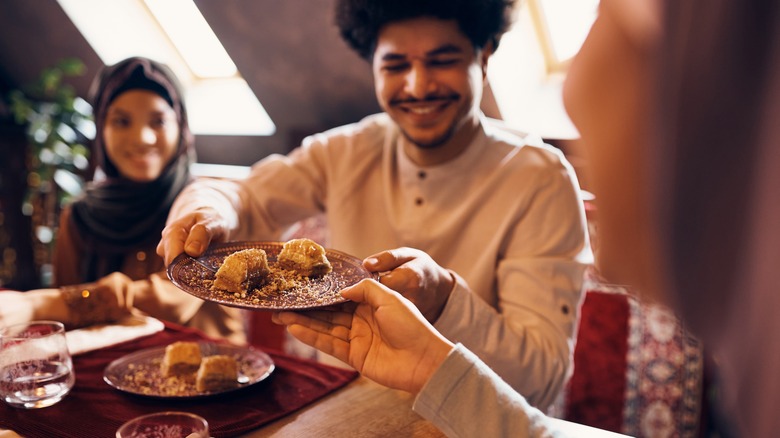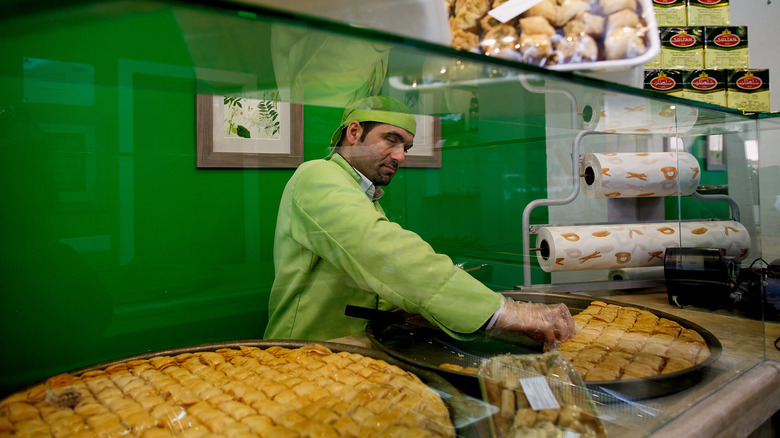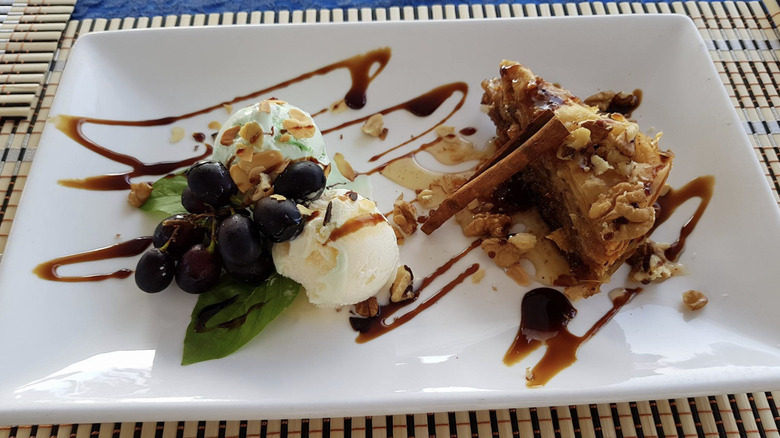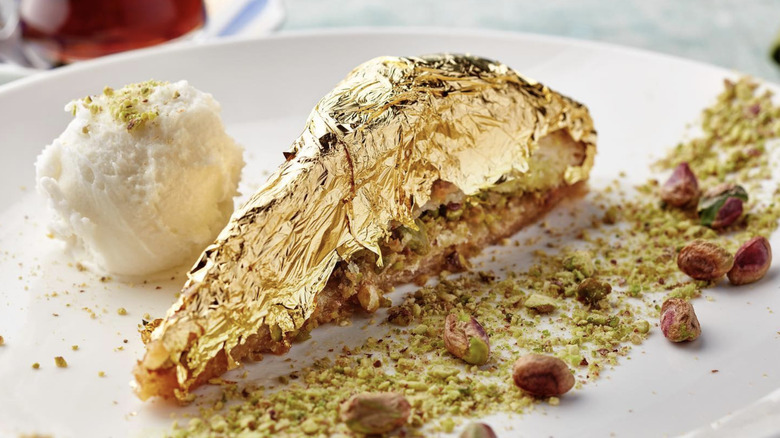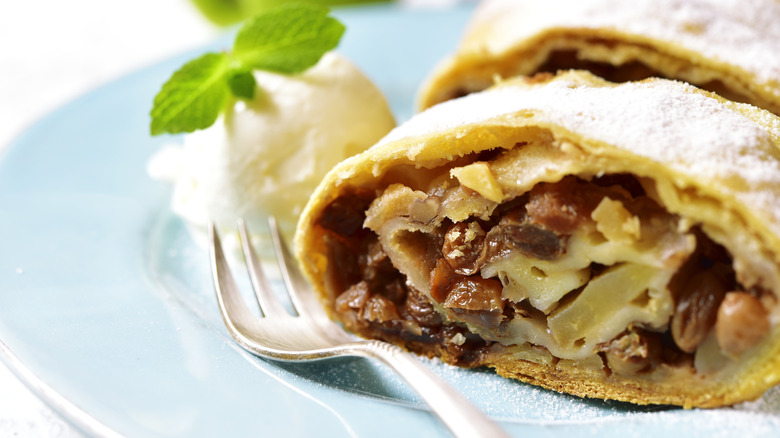Everything You Need To Know About Baklava
Baklava has gained global popularity, crossing borders and captivating dessert lovers with its sweet and nutty allure. Made with wafer-thin layers of flaky pastry, a delectable blend of nuts, and a sweet syrup topping or honey, baklava comes in various eye-catching shapes that only add to its appeal. It's baked on trays and cut into multiple bite-size pieces. It's also commonly enjoyed with a cup of tea or as the final course of a meal.
Influenced by different culinary traditions, baklava serves as a symbol of cultural exchange, showcasing the interconnectedness of different regions through food. The blending of flavors, techniques, and ingredients from various cultures has resulted in unique variations, reflecting the rich landscape of global gastronomy. From classic takes on the dish with chopped pistachios and walnuts to more creative adaptations featuring chocolate, custard, and fruit, this confection continues to evolve, embracing new flavor and texture combinations.
Ready to take a deep dive into the world of baklava? Keep reading to discover more about this beloved dessert!
Baklava's exact origins are disputed
Standing testament to baklava's widespread appeal, several countries, with Turkey and Greece being the foremost contenders, lay claim to its invention. In reality, the exact origins of the sweet treat are uncertain. It's believed that a precursor to baklava existed as early as the 8th century B.C. in ancient Assyria (modern-day Lebanon and Egypt). The initial version of the treat was composed of thinly rolled unleavened dough that was filled with chopped nuts and sweetened with honey.
With the expansion of trade, the ancient Greeks embraced the layered nut dessert, bringing it back to their home country. In fact, it's the Greeks who are believed to have first incorporated phyllo — or the paper-thin pastry we enjoy today — into the dish. While the word phyllo translates to leaf in Greek, the term baklava probably has Turkish origins, further complicating the history of the beloved dessert. Past evidence suggests that baklava was widely popular within the Ottoman Empire, with mentions of the dessert found in notes from 1473 that were discovered in the Topkapi Palace in what was then Constantinople (modern-day Istanbul).
Making baklava from scratch is labor-intensive
Although baklava comes in an array of delicious flavors, it usually consists of multiple sheets of phyllo pastry layered with nuts, butter, and syrup. And while making baklava isn't necessarily difficult, preparing the dessert entirely from scratch can be time-consuming, especially considering that there was no such thing as frozen phyllo pastry sheets in the past.
Some traditional baklava recipes still call for the phyllo sheets to be rolled out one at a time. Since baklava can have as many as 40 paper-thin layers, this can be quite a feat. Reflecting on yesteryear, one Quora user describes the intricate process of making baklava, saying, "My grandmother told me how her mother took a broom stick, broke off the broom part, painted it white and polished with olive oil and would lay out a clean bedsheet on the floor to roll the phyllo dough on."
Once the layers of pastry are rolled out and ready to go — or more likely defrosted — each one needs to be brushed with butter or ghee to keep it from sticking to the other layers. Sonila Zarate from Mediterranean Latin Love Affair offers a time-saving tip, recommending that baklava enthusiasts roll out three or four pastry layers at a time with butter in between to ensure that they separate during the baking process.
Baklava comes in different regional variations
Baklava comes in a multitude of flavors and textures as well as a variety of shapes and sizes. These variations often embody distinct regional characteristics, with different cultures infusing their baklava recipes with specific ingredients.
Turkish baklava is usually made with pistachios or walnuts and cut into a range of shapes, including rectangles, squares, diamonds, and even circles. One intriguing Turkish rendition of this sticky dessert is kaymak baklava, which features a filling made from clotted cream. Greek baklava usually comes with pistachio nuts and honey instead of syrup, and it is typically served in square-shaped portions. Meanwhile, in Lebanon, baklava is usually made with walnuts and is typically lighter with less flakiness and syrup than its Turkish and Greek counterparts.
As highlighted by Tasting Table, baklava is as varied as the imaginations of its creators with some interpretations of the dessert venturing into truly extraordinary territory. One intriguing example is the bülbül yuvası, or nightingale's nest, found in Turkey, the Middle East, and Europe. Rather than being layered, the dessert calls for the dough to be rolled up and then shaped into a circle with a hole in the center that's filled with pistachios and walnuts and covered in syrup. Another interesting take on the sweet is the Bosnian ružice, or rose baklava. These little nuggets of goodness are made with rolled pastry that's filled with walnuts, strudel crumbs, and a touch of clove for added flavor.
Baklava holds religious and cultural significance
While not many realize this when indulging in the nutty dessert, baklava carries deep religious significance in several countries. In Greece, the dessert is traditionally prepared with 33 layers of phyllo to represent each year of Christ's life or 40 layers for each day of Lent. Commonly served alongside other Greek pastries such as kataifi and galaktoboureko, the sweet is often a fixture at Christmas and Easter feasts. Baklava is also a staple during the holy month of Ramadan and Eid ul-Fitr celebrations for Muslims and during Passover for Jews.
Baklava holds a special place in many cultures, where it's eaten at festive gatherings and other special occasions. Many Middle Eastern households serve baklava to guests as a gesture of hospitality and goodwill, while in Greek culture the dessert is commonly associated with family and community bonds. Similarly, in certain Hindu traditions, the sweet delicacy symbolizes abundance and prosperity, serving as an integral part of Diwali celebrations, where it's believed to usher in a prosperous future.
In Turkey, there's even a National Baklava Day that takes place each year on November 17. The day sees baklava enthusiasts celebrate by indulging in the syrupy treat at their favorite bakeries or restaurants, or even preparing it themselves at home.
The largest baklava ever made weighed 1,130 pounds
In 2018, the world witnessed the creation of the heftiest baklava to date at the Ankara Gastronomy Summit in Turkey. Weighing an astonishing 1,130 pounds, the confection shattered the previous Guinness World Record. The colossal baklava was composed of 11,800 square pieces, further highlighting the magnitude of this culinary achievement.
Baked and displayed on a single tray that measured 8.2 feet by 24.6 feet, the mammoth dessert was prepared by a team of 14 chefs led by Mehmet Kanbur, who heads the Turkish ice cream and pastry chain, Mado. The group dedicated an entire six months to preparing for the feat. On the day of the event, it took the chefs five hours to assemble the giant treat, utilizing a 330 pounds of butter and 176 pounds of walnuts. Quoted by Reuters, Kanbur highlighted the significance of baklava in Turkish culture, saying, "As you know Turkish people are born eating sweets and die eating sweets ... This is what we say to the whole world: eat sweet, talk sweet ... This record is a sweet message to the world."
Baklava has a relatively long shelf life
Let's face it, most bakery items come with a very limited shelf life, particularly if they contain custard or frosting made with whipped cream, cream cheese, or eggs. Cakes, pastries, and doughnuts, for instance, can be kept only one or two days on the shelf and for up to a week if refrigerated. Unlike many other desserts, baklava has a considerably longer shelf life due to its high sugar content in the form of honey and syrup. Indeed, baklava tends to become increasingly more juicy and flavorful over time, as the phyllo absorbs the sweet syrup or honey.
Baklava can be stored in the pantry for about two weeks. The syrupy pastry is likely to start drying out as it approaches its use-by date. Alternatively, you can refrigerate baklava for close to three weeks or freeze it for a longer period of up to five months. As a rule of thumb, baklava tends to be crispier if stored in the pantry, and chewier if kept in the refrigerator. Whatever storage method you opt for, it's best to wrap baklava in parchment paper and place it in an airtight container. If not refrigerated, it's important to ensure that the dessert is stored in a dark and cool place.
Baklava has modern variations
While traditional baklava recipes remain popular, modern chefs and pastry enthusiasts have been experimenting with creative takes on the ubiquitous dessert. These sometimes include unconventional ingredients such as chocolate, berries, and even savory ingredients such as ricotta. Contemporary interpretations of the desserts are also often plated in a more creative fashion.
The Modern Nonna has come up with a new version of the treat that combines elements of classic baklava with her grandmother's recipe for Bulgarian custard cookie cake. Utilizing phyllo cups, the dessert comes with a custard filling and a rich topping made with walnuts, cinnamon, and honey. Another fascinating take on tradition can be found at Balaboosta in New York City. Created by the restaurant's owner, Einat Admony, the fried baklava ice cream is a delectable-looking dessert featuring pistachio ice cream, phyllo pastry, spiced nuts, and honey syrup.
With increasing dietary preferences and restrictions among diners, vegan and gluten-free versions of baklava have also become popular. The website Nadia's Healthy Kitchen offers a vegan and gluten-free take on the dessert that utilizes ingredients such as oat flour, ground almonds, and maple syrup instead of butter. Susanna Booth from The Guardian also suggests an alternative approach to the dessert by replacing phyllo pastry with gluten-free Vietnamese rice pancakes in her baklava recipe. To make things even easier, vegans wishing to make their own baklava at home can easily find vegan phyllo pastry at their local grocery stores.
Baklava can get expensive
A single piece of baklava at a pastry shop will typically set you back between $1 and $2.50, depending on the bakery and the type of dessert you purchase. If you order your baklava online, you generally should be prepared to fork out about $20 for 30 pieces of the treat plus the cost of delivery.
While this may not sound like a lot, the price of baklava can vary significantly depending on where you indulge in this delectable treat. Take, for instance, Nusr-et in Mykonos, Greece, where a single slice of baklava will cost you about $27. What sets this particular baklava apart — though some might argue its steep price tag doesn't necessarily justify it — is the unique inclusion of pistachio ice cream and the captivating spectacle of it being filled right at the table in front of the diners. According to Greek City Times, Nusr-et even offers an even more extravagant version of the dessert adorned with edible gold leaf, priced at a staggering $107.
Another restaurant that dresses its baklava in gold is Zou Zou in Dubai. The Turkish and Lebanese restaurant's take on the dessert features phyllo filled with nuts and topped with sugar syrup as well as a 20-gram gold sheet. Considering this extravagance — if the sheet is in fact gold — the dessert's price tag of about $25 may not actually be that high.
Baklava is the predecessor of the strudel
Baklava is considered to be the early precursor of the strudel, as both treats feature layers of pastry made with unleavened dough and filled with a mixture of ingredients. Nevertheless, the desserts do feature distinct regional variations. While baklava is popular for its rich, sweet flavors and use of nuts and honey, strudel has a lighter texture and typically incorporates fruit fillings, reflecting the culinary heritage of Hungary and Austria. Today, strudel is popular across Europe, in countries such as the Czech Republic, Slovenia, Serbia, Croatia, and Romania, each of which has its own version of the dish.
Baklava was first introduced to Hungary and Austria by Turks in the 15th and 16th centuries. Over the years, the pastry chefs of the Austro-Hungarian empire put their own spin on the dish, incorporating it into the region's gastronomic culture as the strudel. From the German word meaning whirlpool, strudel comes in different forms including milk-cream, apple, apricot, peach, and almond. There're even savory strudels that are filled with meat and veggies. The first ever written strudel recipe from 1696 was for a milk-cream version of the dish, and it's still preserved and showcased at the Viennese City Library.
